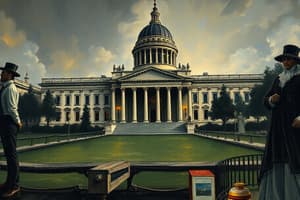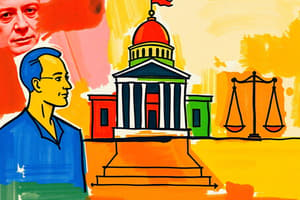Podcast
Questions and Answers
Which of the following components is NOT part of the government structure?
Which of the following components is NOT part of the government structure?
- Executive
- Legislature
- Judicial
- Monarchy (correct)
Sovereignty refers to the ability of a state to make decisions without being subject to a higher authority.
Sovereignty refers to the ability of a state to make decisions without being subject to a higher authority.
True (A)
What is the primary function of the executive branch in government?
What is the primary function of the executive branch in government?
to execute, enforce, and administer laws
The theory that states developed naturally out of early family structures is known as the ______ theory.
The theory that states developed naturally out of early family structures is known as the ______ theory.
Match the theories of state origin with their descriptions:
Match the theories of state origin with their descriptions:
What type of government allows citizens to elect representatives to express popular will?
What type of government allows citizens to elect representatives to express popular will?
In a dictatorship, the people have representation in the government.
In a dictatorship, the people have representation in the government.
What was the primary purpose of the Preamble of the Constitution?
What was the primary purpose of the Preamble of the Constitution?
A legal system based on religious law is known as a ______.
A legal system based on religious law is known as a ______.
Match the following types of government with their definitions:
Match the following types of government with their definitions:
Which of the following is a principle of American democracy?
Which of the following is a principle of American democracy?
The Virginia Plan proposed equal representation for all states in Congress.
The Virginia Plan proposed equal representation for all states in Congress.
What did the Supremacy Clause establish?
What did the Supremacy Clause establish?
The division of power between national, state, and local governments is known as ______.
The division of power between national, state, and local governments is known as ______.
Which amendment process involves a proposal at the national level and approval at the state level?
Which amendment process involves a proposal at the national level and approval at the state level?
Checks and balances allow one branch of government to become too powerful.
Checks and balances allow one branch of government to become too powerful.
What did the Federalists advocate for during the ratification battle?
What did the Federalists advocate for during the ratification battle?
Powers that are reserved only for the states are called ______ powers.
Powers that are reserved only for the states are called ______ powers.
Match the following articles of the Constitution with their descriptions:
Match the following articles of the Constitution with their descriptions:
Which clause allows states to make reasonable distinctions between residents and nonresidents?
Which clause allows states to make reasonable distinctions between residents and nonresidents?
The Senate consists of 435 members.
The Senate consists of 435 members.
What are the two main types of grants-in-aid provided to states?
What are the two main types of grants-in-aid provided to states?
The power of __________ allows Congress to control different groups by withholding funding.
The power of __________ allows Congress to control different groups by withholding funding.
Match the following leadership roles with their responsibilities:
Match the following leadership roles with their responsibilities:
What is a filibuster?
What is a filibuster?
Every member of the House of Representatives serves a term of 4 years.
Every member of the House of Representatives serves a term of 4 years.
What is gerrymandering?
What is gerrymandering?
To be a senator, one must be at least ____ years old.
To be a senator, one must be at least ____ years old.
What is the role of the Appropriations Committee in the House?
What is the role of the Appropriations Committee in the House?
Both the House and the Senate must approve a bill before it becomes law.
Both the House and the Senate must approve a bill before it becomes law.
What power does Congress have in relation to high-level job appointments?
What power does Congress have in relation to high-level job appointments?
A __________ is a motion in the Senate to end a filibuster.
A __________ is a motion in the Senate to end a filibuster.
Match the following types of powers with their definitions:
Match the following types of powers with their definitions:
Flashcards
Government
Government
The organized system of rules and procedures that govern a society. It carries out laws, enforces them and settles disputes.
State (in political science)
State (in political science)
A politically organized body of people living in a defined territory, with the power to enforce laws and make decisions without outside interference.
Sovereignty
Sovereignty
The supreme and absolute power of a state within its borders. It means a state can decide its own affairs, foreign and domestic, without outside control.
3 Branches of Govt
3 Branches of Govt
Signup and view all the flashcards
Major Functions of Government
Major Functions of Government
Signup and view all the flashcards
Direct Democracy
Direct Democracy
Signup and view all the flashcards
Indirect Democracy
Indirect Democracy
Signup and view all the flashcards
Unitary Government
Unitary Government
Signup and view all the flashcards
Federal Government
Federal Government
Signup and view all the flashcards
Confederal Government
Confederal Government
Signup and view all the flashcards
Limited Government
Limited Government
Signup and view all the flashcards
Popular Sovereignty
Popular Sovereignty
Signup and view all the flashcards
Separation of Powers
Separation of Powers
Signup and view all the flashcards
Checks and Balances
Checks and Balances
Signup and view all the flashcards
Federalism
Federalism
Signup and view all the flashcards
Expressed Powers
Expressed Powers
Signup and view all the flashcards
Reserved Powers
Reserved Powers
Signup and view all the flashcards
Concurrent Powers
Concurrent Powers
Signup and view all the flashcards
Supremacy Clause
Supremacy Clause
Signup and view all the flashcards
Judicial Review
Judicial Review
Signup and view all the flashcards
Privileges and Immunities Clause
Privileges and Immunities Clause
Signup and view all the flashcards
Grants-in-Aid
Grants-in-Aid
Signup and view all the flashcards
Block Grant
Block Grant
Signup and view all the flashcards
Categorical Grant
Categorical Grant
Signup and view all the flashcards
Federal Mandates
Federal Mandates
Signup and view all the flashcards
Expressed Powers of Congress
Expressed Powers of Congress
Signup and view all the flashcards
Implied Powers of Congress
Implied Powers of Congress
Signup and view all the flashcards
Veto
Veto
Signup and view all the flashcards
Power of the Purse
Power of the Purse
Signup and view all the flashcards
Oversight
Oversight
Signup and view all the flashcards
Gridlock
Gridlock
Signup and view all the flashcards
Reapportionment
Reapportionment
Signup and view all the flashcards
Study Notes
Government Structure and Functions
- Government is composed of three branches: the legislative (makes laws), executive (enforces laws), and judicial (interprets laws).
- A state is a body of people, living in a defined territory, with an organized government, and the power to make and enforce laws without higher authority.
- Key characteristics of a state include population, territory, and sovereignty (supreme power within its boundaries).
Major Functions of Government
- Establishing justice and ensuring domestic tranquility (maintaining peace).
- Providing for the common defense and promoting the general welfare (e.g., public goods).
- Securing the blessings of liberty (protecting freedoms).
Origins of the State
- Force Theory: States emerge from forceful control by a person or group.
- Evolutionary Theory: States naturally develop from families and groups.
- Divine Right Theory: Rulers are chosen by God. (historical perspective, challenged by social contract theory).
- Social Contract Theory: People voluntarily give up some freedoms to be governed, forming a society.
Types of Government
- Democracy: Supreme authority resides with the people.
- Direct Democracy: Citizens directly make laws.
- Indirect Democracy: Citizens elect representatives.
- Dictatorship: Absolute authority, no representation.
- Autocracy: One person holds unlimited power.
- Oligarchy: Small group holds power.
- Theocracy: Legal system based on religious law.
Organizing National Power
- Unitary: Centralized government holds all power.
- Federal: Power divided between central and local governments.
- Confederal: Alliance of independent states with weak national government.
American Democracy Principles
- Ordered government: Government maintains order.
- Limited government: Government power is restricted.
- Representative government: Citizens elect representatives.
Beginnings of American Government
- Initial intent was to revise the Articles of Confederation, ending up with a new Constitution.
- Virginia Plan: Representation based on population.
- New Jersey Plan: Each state receives equal representation.
- Connecticut Compromise: Bicameral legislature; one house based on population (House), the other with equal representation (Senate).
- Federalists vs. Anti-Federalists: Debate over the Constitution's ratification.
The Constitution and Federalism
The Constitution
- Structure of the Constitution: Preamble, seven articles, amendments.
- Core Principles: Popular sovereignty, limited government, separation of powers, checks and balances, federalism.
- Three Branches: Legislative (Congress), Executive (President), Judicial (Supreme Court).
- Checks and Balances: Systems that prevent any branch from becoming too powerful.
- Marbury v. Madison: Established judicial review.
Federalism
- National Powers (expressed, implied, inherent): Powers explicitly granted, implied by expressed powers, and inherent powers of a sovereign nation.
- State Powers (reserved): Powers not explicitly given to national government but reserved for the states.
- Shared Powers (concurrent): Powers exercised by both national and state governments. (e.g., taxation, lawmaking).
- Relationship between States: Full faith and credit, privileges and immunities, supremacy clause.
The Legislative Branch
- Powers of Congress: Expressed (stated) and implied powers.
- Limits on Congress: Checks and balances, Constitution limits on powers
- Power of the Purse: Congress' control over finances.
- Oversight: Investigation and monitoring of government actions.
- Gridlock: Inability to reach agreement in Congress.
- Non-Legislative Powers: Approving appointments, ratifying treaties, impeachment.
- House of Representatives: Representation based on population, two-year terms, special rules for debate. Speaker of the House.
- Senate: Equal representation per state, six-year terms, continuous body, filibuster, cloture.. President of the Senate.
Legislative Process
- Bills are introduced, debated and amended, voted on in both Chambers, and if approved, are signed into law by the President.
- Different paths for bills to take.
- Conference Committees: reconcile differences between House and Senate versions of bills.
The President
The Judicial Branch
Amendments and the Process
Studying That Suits You
Use AI to generate personalized quizzes and flashcards to suit your learning preferences.




